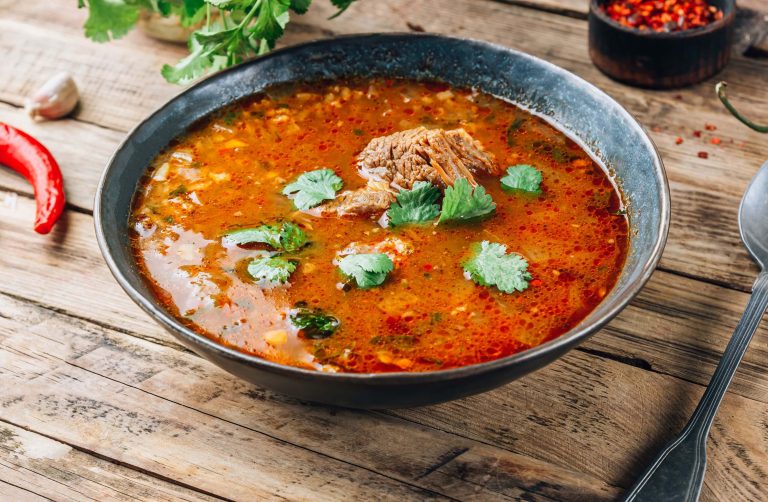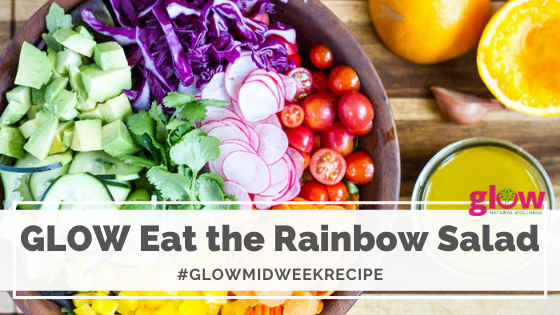

GLOW Eat the Rainbow Salad
This week’s challenge was to “Eat the Rainbow” of vegetables and fruit.
We often get into a rut and eat the same veggies over and over again. It’s important to include a variety of fruits and vegetables in our diets and to include the full spectrum of colors.
Each color, and more specifically each fruit and vegetable, represents a unique spectrum of phytochemicals.
By eating a variety of colorful whole foods, you are providing your body with a wide array of health-promoting and disease-fighting nutrients.
Here are some of the benefits of each color:
Red
Natural plant pigments called lycopene and anthocyanins provide the red color. Lycopene is a carotenoid, a powerful antioxidant that may help reduce the risk of several types of cancer, especially prostate cancer. The most concentrated source of lycopene is found in tomato products. Specifically, cooked tomato products such as tomato sauce with a little bit of fat (olive oil) are absorbed better than lycopene from raw tomatoes. Anthocyanins can be found in strawberries, raspberries, cranberries, red grapes, rhubarb, and beets. They act as powerful antioxidants to support a healthy urinary tract and may promote a healthy heart by lowering blood pressure and cholesterol.
Examples of red foods: Red Apples, Pomegranates, Red Potatoes, Watermelon, Pink Grapefruit, Blood Oranges, Red Cabbage, Cherries, Radishes.
Green
The green color of all plants is from a natural plant pigment called chlorophyll. Some green fruits and vegetables, such as dark leafy greens, cucumber, and celery, contain Lutein. Lutein works with another chemical, zeaxanthin, found in corn, egg yolks, and oranges to help keep eyes healthy. Green vegetables are excellent sources of potassium, carotenoids, omega-3s, and vitamin K. Diets high in potassium are linked with lower blood pressure; vitamin K is necessary for blood clot formation.
Examples of green foods: Honeydew Melon, Artichokes, Kiwi, Asparagus, Lettuce, Avocadoes, Limes, Green Beans, Green Onions, Brussels Sprouts, Green Pepper, Spinach, Zucchini, Green Grapes.
Yellow & Orange
Carotenoids, a natural plant pigment, provide yellow or orange color. Beta-carotene, beta-cryptoxanthin and alpha-carotene are all orange friendly carotenoids that can be converted in the body to vitamin A, an integral nutrient for vision and immune function as well as skin and bone health. Citrus fruits like oranges and tangerines are an excellent source of vitamin C and folate. Considered eyesight foods, they also play a role in overall immune health, heart health, and reduced risk of cancer.
Examples of yellow and orange foods: Yellow Apples, Peaches, Apricots, Pears, Butternut Squash, Yellow Peppers, Cantaloupe, Persimmons, Pineapple, Grapefruit, Pumpkin, Lemons, Mangoes, Yellow Summer or Winter Squash, Nectarines, Papaya.
Blue & Purple
A natural plant pigment called anthocyanins provides the color to blue and purple fruits and veggies. Anthocyanins act as a powerful antioxidant that protects cells from damage promotes heart health and healthy blood pressure.
Blues and purples also help to reduce the risk of stroke and may help lower the risk of cancer. The darker in color blues and purples are, the higher the phytochemical concentration. Blueberries are considered to have the highest antioxidant activity of all fruits and vegetables. Other studies show that eating more blueberries is linked with improved memory function and healthy aging.
Examples of blue and purple foods: Eggplant, Figs, Plums, Prunes, Raisins, Purple Asparagus.
White
White fruits and vegetables get their color from a natural plant pigment called anthoxanthins. Allicin is a health-promoting chemical found in the white group that may help to lower cholesterol and blood pressure, as well as reduce the risk of stomach cancer and heart disease. Members of the white group, such as bananas and potatoes, are high in potassium, which is linked to lowered blood pressure and overall better heart health.
The largest class of phytochemicals are the flavonoids which are, for the most part, colorless. These are powerful antioxidants that help the body counteract free-radical formation, which fights disease. Flavonoids are found in a variety of color groups. Think of the inside of eggplant or an apple, which is white. This is an example of where they can be found within all the color groups.
Examples of white foods: Garlic, Onions, Parsnips, Turnips, White Asparagus, Ginger, Jicama, Mushrooms.
Make it a goal to choose 4-5 different vegetables and fruits each week, and work them into your diet. Aim for 2-3 cups of veggies per meal for optimal nutrition benefits. Try the GLOW Eat the Rainbow Salad this week for a quick and easy way to eat the rainbow of colors this week!
INGREDIENTS
FOR THE SALAD
- 3-4 cups Salad Greens (I like a mix of Spinach, Arugula, and Kale)
- 1 cup Cherry Tomatoes, sliced in half
- 2 Carrots, thinly sliced
- 6 small Radishes, thinly sliced
- 1 small Red Pepper, chopped
- 1 Avocado, chopped
- 1 Cucumber, thinly sliced or spiralized
- 1 cups shredded Purple Cabbage
- a handful of Fresh Cilantro or Parsley, chopped
- ½ cup Blueberries, Blackberries or Raspberries
- ½ cup Apple, chopped (choose your favorite color!)
FOR THE ORANGE VINAIGRETTE
- 3/4 cup Olive Oil
- 2 tbs Apple Cider Vinegar
- juice from one Orange
- 1 tsp Orange Zest
- 1/2 of a Shallot, minced
- 1 clove Garlic, minced
- 1 tsp Dijon Mustard
- Salt and Pepper, to taste
GARNISH
Optional: Hemp Seeds, Pumpkin Seeds, Almonds, Walnuts
INSTRUCTIONS
- Prepare the dressing by adding everything except salt and pepper to a glass jar or small bowl. Mix or shake until well incorporated. Add salt and pepper to taste. Set aside.
- To assemble the salad, add salad greens to a large bowl. Arrange vegetables in rainbow color order or throw them in and mix.
- Serve with orange vinaigrette dressing. Enjoy!
Recipe Notes: Serve as is as a complete meal, or add in some grilled chicken, steak, or fish for added protein, or to make it a heartier meal. Use your favorite fruits and vegetables to make it your OWN rainbow salad!
- Posted
- in Diet and Nutrition
- By Dr. Michelle






4 Comments
Your point of view caught my eye and was very interesting. Thanks. I have a question for you. https://accounts.binance.com/bg/register-person?ref=S5H7X3LP
Certains logiciels détectent les informations d’enregistrement d’écran et ne peuvent pas prendre de capture d’écran du téléphone mobile. Dans ce cas, vous pouvez utiliser la surveillance à distance pour afficher le contenu de l’écran d’un autre téléphone mobile.
buying prescription drugs in mexico online: medicine in mexico pharmacies – mexican border pharmacies shipping to usa
online shopping pharmacy india https://indiaph24.store/# top 10 online pharmacy in india
pharmacy website india